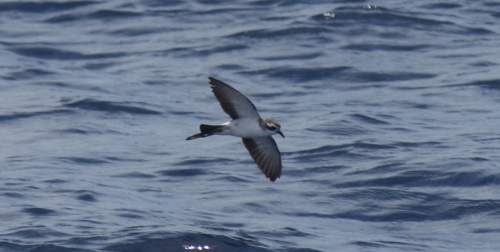The Kermadecs – Seabirds fact sheet
The Kermadec Islands form a seabird refuge of major international importance. Thirty-nine of the 85 seabird species occurring in New Zealand waters have been recorded here, ranging from tiny storm petrels to large wandering albatrosses. It’s a cosmopolitan mix of tropical, subtropical, temperate and endemic species. They include five endemic species and five ranked as Vulnerable on the IUCN Red List of Threatened Species.
The isolation of the islands, and their location in the midst of productive seas, make them a prime breeding ground. Up to an estimated 6 million seabirds breed here each year[1], a similar population size to that estimated for all the Hawaiian Islands[2]. (Including non-breeding seabirds, the total population could be as high as 10–15 million.) The islands are nationally important as the only New Zealand breeding ground for 12 of the 14 mainly tropical species of shearwater, petrel, storm petrel, booby, tropicbird, tern and noddy.
The entire world populations of the endemic Kermadec storm petrel and Kermadec little shearwater breed at the Herald Islands off Raoul Island, at Macauley Island, and at nearby Haszard Islet. Over 99% of the world population of the globally threatened, endemic white-naped petrel and the world’s largest population of black-winged petrel (approximately 5 million birds) breed at Macauley Island[3].
A globally important population of the Tasman booby breeds at Curtis Island and the Herald Islands, one of only three breeding populations in the world. And until the early twentieth century, the Kermadec Islands were the site of a vast population of summer-breeding Kermadec petrels, alongside a large winter-breeding population of the same species. This is the only site in the world where this phenomenon is known to have occurred.
POPULATION RECOVERY
The Kermadec Islands – especially Raoul – are at the forefront of international efforts to save and restore threatened seabird species and populations.B eginning in the 1970s, the eradication of pests has paved the way for the recovery of seabird populations in their millions.
Black-winged petrels have signalled their triumphant return with daytime display-calling over forests and valleys from scattered small colonies established around Raoul. Their chicks are surviving to fly, and the adults are no longer eaten by feral cats. Wedge-tailed shearwaters have established a stronghold at Raoul Island on the terraces near the DOC field base. Sooty terns increase in numbers on Raoul each year. Tropicbirds are a familiar presence at headlands and are likely to be breeding in some inaccessible places. And Kermadec petrels have been heard increasingly over forests on the eastern end of the island, with a chick found at Nash’s Point in 2004.
For the white-naped petrel (also called Sunday Island petrel), the return to Raoul Island has been mixed. Two birds have been found on a beach there (in 2005 and 2006), both covered in the spiny burs of a native grass dubbed ‘Velcro-grass’ by DOC staff, which prevent birds from flying. Most recently, in 2008, two Kermadec storm petrels, attracted by the lights of the DOC hostel, landed on the veranda, thus raising the possibility that this species is also prospecting for nesting sites at Raoul Island. This is significant, because the smallest seabirds are the most vulnerable to predation and, had they been on Raoul Island originally, Kermadec storm petrels would have been the first species to disappear after Pacific rats were introduced.
In a move to speed up recolonisation, DOC staff installed three broadcast sound systems on headlands, playing a variety of petrel calls at different times of the year. This has been a highly successful technique for attracting prospecting seabirds, particularly younger birds, to establish colonies nearby.
FORAGING STRATEGIES AND RANGES
Most Kermadec species adopt a number of foraging strategies. Principal among these is to feed in multi-species flocks in association with sub-surface marine predators such as tunas[4]. Other strategies included scavenging, nocturnal feeding (especially for petrels) and daytime feeding on invertebrates, fish eggs and larvae. Other species excel at plunge diving. Tasman boobies chase and catch flying fishes in flight or just after they land in the water[5]. Immature boobies have been seen accompanying a ship and chasing flying fishes that flew from the bow-wave[6]. Red-tailed tropicbirds also feed by plunging, often from considerable heights[7].
KERMADEC SEABIRD FORAGING RANGES
Kermadec seabirds can, in general, be split into two groups based on their foraging ranges (although some species fit in both): pelagic species feeding offshore and species feeding closer to the islands. Most Kermadec seabirds have been observed feeding along the Kermadec Arc, often within sight of islands.
Storm petrels have been seen feeding 150 km from their colonies within a few days of being spotted feeding close to Macauley and Curtis islands. Wedge-tailed shearwaters have been observed among large mixed flocks foraging short distances from islands, and yet can also be found feeding in flocks well offshore. White terns can be found well out to sea, although they can also be observed feeding just outside the surf-line at Raoul Island. Likewise, grey ternlets, which feed in massed flocks over the currents and eddies running between the Herald Islands, can also be seen in small flocks returning to islands from offshore. The movement of pelagic species such as black-winged, Kermadec and white-naped petrels through inshore waters during the daytime, as they leave or return to colonies on shore, adds further to the mix of seabird activity in the vicinity of the islands.
SEABIRDS IN THE WIDER KERMADEC REGION
Seabirds that breed outside the region are present in Kermadec waters throughout the year, usually scattered widely across it in any given period. So far, 39 seabird species have been recorded for the Kermadec region and seas to the north and northeast of the New Zealand mainland. Of these, only six are tropical seabirds; the others are southern-breeding seabirds, ranging from southern storm petrels, New Zealand and subantartic petrels to albatrosses and shearwaters.
 Photo: Gareth Rapley
Photo: Gareth RapleyKermadec storm petrel.
[1] Merton 1970; Taylor 2000 a,b; Veitch et al. 2004
[2] Harrison 1990
[3] Taylor 2000 a,b
[4] Ballance & Pitman 1999
[5] Robertson & Heather 2000; G.A. Taylor, pers. comm.
[6] C. Gaskin, pers. comm. 2009
[7] Harrison 1990







